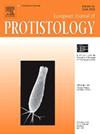Testate amoebae are informative bioindicators of critically high ammonia deposition on peatlands
IF 1.6
2区 生物学
Q4 MICROBIOLOGY
引用次数: 0
Abstract
The global nitrogen cycle has been majorly disrupted by anthropogenic activity. While nitrogen emissions in the UK and Ireland are declining, ammonia (NH3) remains a significant exception. NH3 emissions are mostly agriculturally sourced and deposited on nearby habitats at high rates in both countries. Peatlands are globally important wetlands that are vulnerable to NH3 deposition. Essential peatland restoration risks being diminished by excessive NH3 deposition, leading to the loss of valuable ecosystem services. This study investigates testate amoebae (indicators of contemporary and historic peatland conditions) as bioindicators of seasonal NH3 deposition on six peatlands across Northern Ireland, UK. Sphagnum, an NH3-sensitive bryophyte, was sampled adjacent to NH3 monitoring sites once per season for a year. When NH3 deposition was critically high, multivariate analysis demonstrates a link between NH3 and testate amoebae assemblage change. Similarly, at high NH3 deposition sites, testate amoebae taxa diversity is observed to be significantly reduced in springtime, when it is expected to be highest. Although, in response to high NH3 deposition large algivorous taxa do not proliferate as was anticipated, and mixotrophic taxa abundance decreases could not be linked primarily to NH3. This research demonstrates the continued potential of testate amoebae as highly informative peatland bioindicators.
遗存变形虫是泥炭地高氨沉降的重要生物指标
全球氮循环主要受到人为活动的破坏。虽然英国和爱尔兰的氮排放量正在下降,但氨(NH3)仍然是一个显著的例外。在这两个国家,NH3的排放主要来自农业,并以很高的速率沉积在附近的栖息地。泥炭地是全球重要的易受NH3沉积影响的湿地。过量的NH3沉积降低了泥炭地恢复的风险,导致宝贵的生态系统服务功能丧失。本研究调查了英国北爱尔兰6个泥炭地季节性NH3沉积的生物指标——遗存变形虫(当代和历史泥炭地条件的指标)。对NH3敏感的苔藓植物Sphagnum每季在NH3监测点附近取样1次。当NH3沉积达到临界高时,多变量分析表明NH3与睾丸变形虫组合变化之间存在联系。同样,在高NH3沉降点,研究发现,春季变形虫类群多样性显著减少,而春季是变形虫多样性最高的季节。然而,在高NH3沉积的影响下,大型食藻类群并没有像预期的那样增殖,混合营养类群丰度的减少也不可能主要与NH3有关。这项研究证明了遗属变形虫作为泥炭地生物指示物的持续潜力。
本文章由计算机程序翻译,如有差异,请以英文原文为准。
求助全文
约1分钟内获得全文
求助全文
来源期刊

European journal of protistology
生物-微生物学
CiteScore
4.60
自引率
20.70%
发文量
55
审稿时长
14.6 weeks
期刊介绍:
Articles deal with protists, unicellular organisms encountered free-living in various habitats or as parasites or used in basic research or applications. The European Journal of Protistology covers topics such as the structure and systematics of protists, their development, ecology, molecular biology and physiology. Beside publishing original articles the journal offers a forum for announcing scientific meetings. Reviews of recently published books are included as well. With its diversity of topics, the European Journal of Protistology is an essential source of information for every active protistologist and for biologists of various fields.
 求助内容:
求助内容: 应助结果提醒方式:
应助结果提醒方式:


